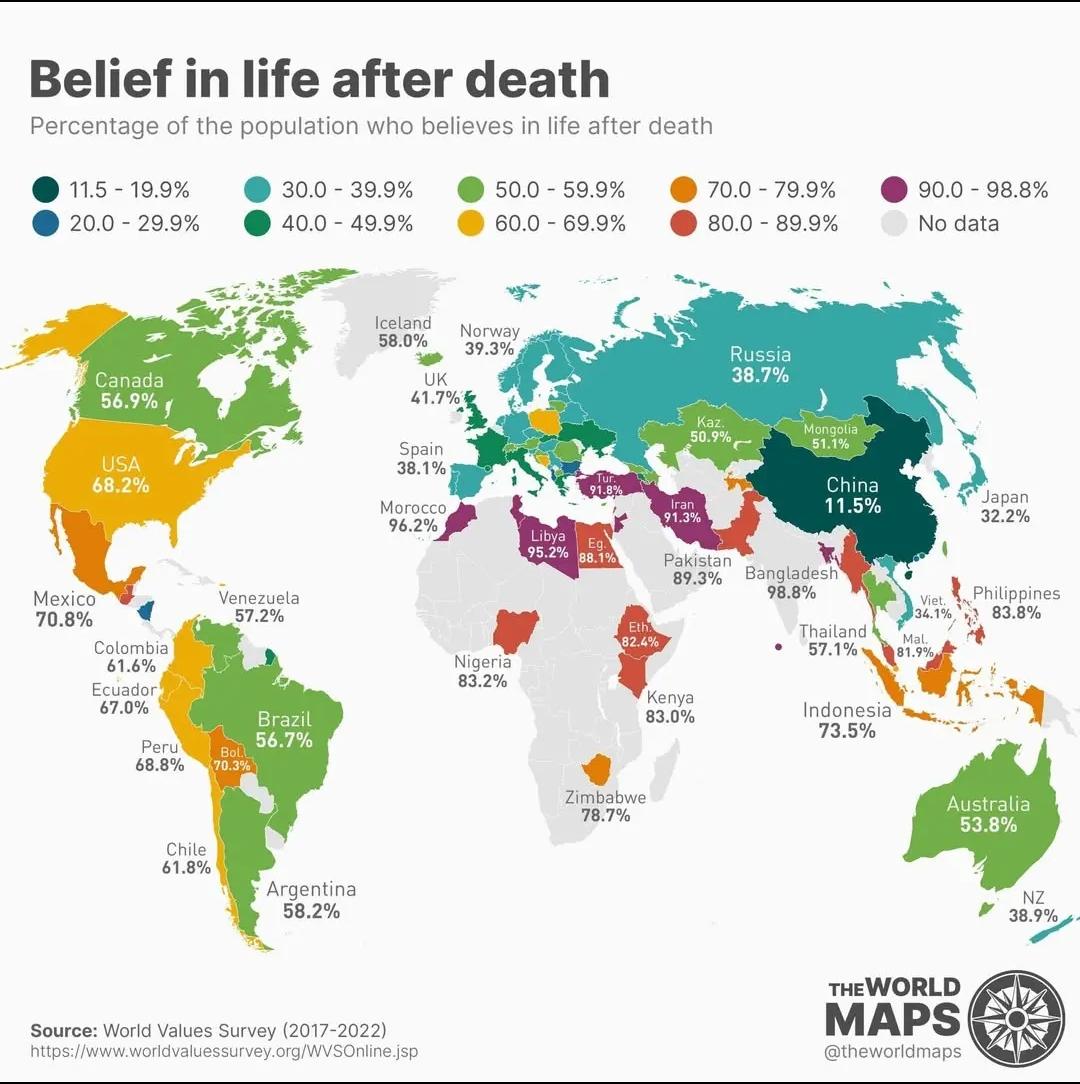% Belief in Life After Death by Country Map


David Chen
Data Visualization Specialist
David Chen is an expert in transforming complex geographic datasets into compelling visual narratives. He combines his background in computer science ...
Geographic Analysis
What This Map Shows
This map visualizes the percentage of people in various countries who believe in life after death. By examining this data, we gain insight into cultural, religious, and societal attitudes surrounding the concept of an afterlife. Belief in life after death often reflects deep-seated traditions and influences how communities perceive mortality and existence beyond this life.
Deep Dive into Belief in Life After Death
Belief in life after death is a topic that transcends borders, deeply rooted in various religions and cultural practices worldwide. Across different societies, the concept of an afterlife is influenced by religious teachings, philosophical views, and cultural narratives. For instance, in many Judeo-Christian contexts, life after death is a fundamental belief, where concepts such as heaven and hell play a significant role in guiding moral behavior and life choices. Interestingly, a survey by the Pew Research Center reveals that about 70% of Christians in the U.S. hold firm beliefs in an afterlife.
On the other hand, in countries with predominantly non-theistic religions, such as Buddhism and certain secular cultures, beliefs may vary significantly. Buddhism, for instance, emphasizes reincarnation rather than a singular afterlife, leading to a different interpretation of existence beyond death. In countries like Thailand and Cambodia, where Buddhism is prevalent, belief in some form of continued existence after death remains strong, albeit distinct from Western concepts of heaven or hell.
Moreover, in regions influenced by indigenous beliefs, such as parts of Africa and South America, views on the afterlife can be intricately tied to ancestral worship and the spiritual connection to nature. The belief in spirits and the continuation of life in a different realm is often prevalent, reflecting rich cultural heritages.
Ever wondered why some regions show a high percentage of belief in life after death while others display skepticism? This can often be attributed to historical, social, and educational factors. In many Western countries, secularization has led to a decline in traditional religious beliefs, resulting in a lower percentage of those who believe in an afterlife. Conversely, in regions with strong ties to traditional religions, such as in parts of the Middle East and Africa, belief remains high, with many individuals finding comfort and meaning in the concept of life beyond death.
Regional Analysis
Looking at the map, we can discern significant regional variations in belief in life after death. In North America, belief rates hover around 50-70%, with Americans often citing religious affiliation as a strong factor influencing their views. In contrast, many Scandinavian countries show lower percentages, often below 30%, reflecting their more secular outlook.
In Asia, the picture is mixed. Countries like India, where Hinduism is predominant, reflect high percentages of belief in an afterlife due to the principles of karma and reincarnation. Conversely, in more secular states like Japan, the belief is nuanced and often blends traditional Shinto practices with modern secular thought, resulting in varied responses in surveys.
Africa offers a complex tapestry of beliefs. Nations such as Nigeria and Ghana display overwhelming belief in life after death, often tied to Christianity and indigenous beliefs. Meanwhile, in countries facing rapid modernity and urbanization, such as South Africa, younger populations may express skepticism, reflecting global trends of secularization.
Significance and Impact
Understanding belief in life after death has broader implications for society. These beliefs can influence social behaviors, ethical frameworks, and even political landscapes. For example, countries with higher percentages of belief in life after death often demonstrate strong community ties and a sense of shared morality grounded in religious teachings. This can foster resilience in times of crisis, as individuals draw comfort from their beliefs about what lies beyond.
Interestingly, current trends show a growing interest in spirituality and alternative beliefs, even in secular nations. This suggests a potential resurgence in discussions around life after death, possibly influenced by global events and the search for meaning in an increasingly complex world. As we look to the future, will belief in life after death remain a cornerstone of human experience, or will it evolve into something new? Only time will tell, but the ongoing dialogue around this topic continues to shape our understanding of humanity's quest for meaning.
Visualization Details
- Published
- August 12, 2025
- Views
- 198
Comments
Loading comments...